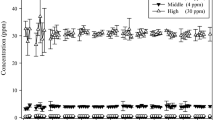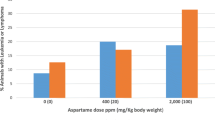Abstract
Our previous studies have demonstrated that doses of 300–50 mg/kg 4-(methylnitrosamino)-1-(3-pyridyl)-1-butanone (NNK) injected subcutaneously into pregnant hamsters cause a 44% incidence of respiratorytract tumors in the offspring. In this study, we have extended the assay of the carcinogenic potency of NNK to doses ranging from 50 mg to 0.05 mg/kg body weight and to a second route of administration, intratracheal instillation, which is more relevant to inhalation of tobacco smoke by pregnant women. Among the offspring whose mothers had been injected subcutaneously with NNK (20–1 mg/kg), the total tumor incidence (57.2%–16.7%) decreased with decreasing dose levels. After intratracheal instillation of 50–0.05 mg/kg NNK the overall incidence varied from 28.6% to 50% but no dose response was observed. The main target organs were the adrenal glands (Phaechromocytomas) and nasal cavities (adenocarcinomas of the olfactory region). A low incidence of ductular adenomas of the pancreas was observed with low doses of NNK instilled intratracheally. These results demonstrate that NNK, at doses that are comparable to the cumulative exposure during a 9-month period in women, is a potent transplacental carcinogen in hamsters.
Similar content being viewed by others
References
Anderson LM, Hecht SS, Dixon DE, Bove LF, Kovatch RM, Amin S, Hoffmann D, Rice JM (1989) Evaluation of the transplacental tumorigenicity of the tobacco-specific carcinogen 4-(methylnitrosamino)-1-(3-pyridyl)-1-butanone in mice. Cancer Res 49:3770–3775
Correa E, Joshi PA, Castonguay A, Schüller HM (1990) The tobacco-specific nitrosamine 4-(methylnitrosamino)-1-(3-pyridyl)-1-butanone is an active transplacental carcinogen in Syrian golden hamsters. Cancer Res 50:3435–3438
Hecht SS, Hoffmann D (1989) The relevance of tobacco-specific nitrosamines to human cancer. Cancer Surv 8:273–294
Jorquera R, Castonguay A, Schüller HM (1992) Placental transfer of 4-(methylnitrosamino)-1-(3-pyridyl)-1-butanone instilled intratracheally in Syrian golden hamsters. Cancer Res 52:3272–3280
Mohr U, Reznik-Schüller HM, Reznik G, Hilfrich J (1975) Transplacemental effects of diethylnitrosamine in Syrian golden hamsters as related to different days of administration during pregnancy. J Natl Cancer Inst 55:681–683
Pour P (1986) Induction of exocrine pancreatic, bile duct and thyroid gland tumors in offspring of Syrian golden hamsters treated withN-nitrosobis(2-oxopropyl)amine during pregnancy. Cancer Res 46:3663–3666
Sandler DP, Everson RB, Wilcox AJ, Browder JP (1985) Cancer in adulthood from early life exposure to parents' smoking. Am J Public Health 75:487–492
Stjernfeld M, Lindsten J, Bergland K, Ludwigson J (1986) Maternal smoking during pregnancy and risk of childhood cancer. Lancet I:1350–1352
Author information
Authors and Affiliations
Additional information
This study was suported by grant RO1 CA42829 from the National Cancer Institute (USA)
Rights and permissions
About this article
Cite this article
Schüller, H.M., Jorquera, R., Lu, X. et al. Transplacental carcinogenicity of low doses of 4-(methylnitrosamino)-1-(3-pyridyl)-1-butanone administered subcutaneously or intratracheally to hamsters. J Cancer Res Clin Oncol 120, 200–203 (1994). https://doi.org/10.1007/BF01372556
Received:
Accepted:
Issue Date:
DOI: https://doi.org/10.1007/BF01372556




